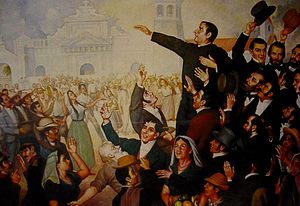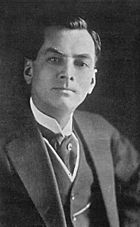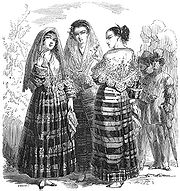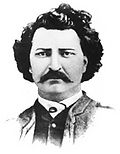
Mestizo
Background Information
Arranging a Wikipedia selection for schools in the developing world without internet was an initiative by SOS Children. A quick link for child sponsorship is http://www.sponsor-a-child.org.uk/
 |
| Notable mestizos: Porfirio Díaz (above) • Inca Garcilaso de la Vega |
| Regions with significant populations |
|---|
| Caribbean Latin America United States |
| Languages |
|
Predominantly Spanish |
| Religion |
|
Predominantly Roman Catholicism |
| Related ethnic groups |
|
European peoples |
Mestizo /mɛˈstizoʊ/ is a term traditionally used in Spain, Latin America, and the Philippines for people who identify as having mixed descent. In Venezuela, mestizo means being mixed without specifying which admixture. The term was used as a racial category in the Casta system that was in use during the Spanish empire's control of their American colonies; it was used to describe those who had one European-born parent and one who was a member of an indigenous American population in some countries, while it was used to refer to people of various admixture in others like Venezuela. In the Casta system mestizos had fewer rights than European-born persons called " Peninsulares", and " Creoles" who were persons born in the New World of two European-born parents, but more rights than " Indios" and Negros. During the colonial period, mestizos quickly became the majority group in much of what is today Latin America, and when the colonies started achieving independence from Spain, the mestizo group often became dominant. In some Latin American countries, such as Mexico, the concept of the "mestizo" became central to the formation of a new independent identity that was neither wholly Spanish nor wholly indigenous and the word mestizo acquired its current double meaning of mixed cultural heritage and descent.
Etymology
The Spanish word Mestizo is from the Romance / Latin word mixticius, meaning mixed. Its usage has been documented as early as 1275, to refer to the offspring of an Egyptian and a Jew. This term was first documented in English in 1582.
Cognates
Mestizo (Spanish: [mesˈtiθo] or [mesˈtiso]), Mestiço (Portuguese: [mɨʃˈtisu], [mesˈtisu] or [mesˈtʃisu]), Métis (French: [meˈtis]), Mestís (Catalan: [məsˈtis]), Meticcio (Italian: [meˈtittʃo]), Mestiezen (Dutch: [mesˈtizən]), Mestee (Middle English: [məsˈtiː]), and Mix (English) are all cognates of the Latin word mixticius.
History
During the Spanish colonial period, the Spanish developed a complex caste system based on race, which was used for social control and which also determined a person's importance in society. There were four main categories of race: (1) Peninsular — a person of Spanish descent born in Spain, (2) Criollo (fem. criolla) — a person of Spanish descent born in the Americas, (3) Indio (fem. India) — a person who is a native of, or indigenous to the Americas, and (4) Negro (fem. Negra) — a person of African descent. Persons of mixed race were collectively referred to as castas. During this era, myriad other terms (such as mulatto and zambo) were used to differentiate racial mixtures. By the end of the colonial period in 1821, over one hundred categories of possible variations of mixture existed. In theory, Criollo status could also be attained by people of mixed origin who had the equivalent of a great grandparent with Amerindian ancestry. Such cases might include the offspring of a Castizo (3/4 Spanish, 1/4 Indian) parent and one Peninsular or Criollo parent. This one-eighth rule, also in theory, did not apply to African admixture. A person's legal racial classification in colonial Spanish America was closely tied to social status, wealth, culture and language use. Wealthy people paid to change or obscure their actual ancestry. Many indigenous people left their traditional villages and sought to be counted as mestizos to avoid tribute payments to the Spanish. Many indigenous people, and sometimes those with partial African descent, were classified as mestizo if they spoke Spanish and lived as mestizos.
Often, but only early on, the term mestizo was associated with llegitimacy; The term also has a pejorative use about something that is not "pure". However, it evolved in the ensuing centuries. According to historians Michael C. Meyer and William L. Sherman, early in the 16th century Spanish colonial usage of the term, mestizo "was almost synonymous with bastard" ( illegitimate child).
Because the term had taken on a myriad of meanings, the designation "Mestizo" was removed from census counts in Mexico and is no longer in use.
Spanish-speaking Latin America
Mexico
The large majority of Mexicans can be classified as "Mestizos", meaning in modern Mexican usage that they identify fully neither with any indigenous culture nor with a particular non-Mexican heritage, but rather identify as having cultural traits and heritage incorporating elements from indigenous and European traditions. By the deliberate efforts of post-revolutionary governments the "Mestizo identity" was constructed as the base of the modern Mexican national identity, through a process of cultural synthesis referred to as mestizaje [mes.ti.'sa.xe]. Mexican politicians and reformers such as José Vasconcelos and Manuel Gamio were instrumental in building a Mexican national identity on the concept of mestizaje. Cultural policies in early post-revolutionary Mexico were paternalistic towards the indigenous people, with efforts designed to "help" indigenous peoples achieve the same level of progress as the rest of society, eventually assimilating indigenous peoples completely to Mestizo Mexican culture, working toward the goal of eventually solving the "Indian problem" by transforming indigenous communities into mestizo communities.
The term "Mestizo" is not in wide use in Mexican society today and has been dropped as a category in population censuses; it is, however, still used in social and cultural studies when referring to the non-indigenous part of the Mexican population. The word has somewhat pejorative connotations and most of the Mexican citizens who would be defined as mestizos in the sociological literature would probably self-identify primarily as Mexicans. In the Yucatán peninsula the word Mestizo is even used about Maya-speaking populations living in traditional communities, because during the caste war of the late 19th century those Maya who did not join the rebellion were classified as mestizos. In Chiapas the word "Ladino" is used instead of mestizo.
Sometimes, particularly outside of Mexico, the word "mestizo" is used with the meaning of Mexican persons with mixed Indigenous and European blood. This usage does not conform to the Mexican social reality where a person of pure indigenous genetic heritage would be considered Mestizo either by rejecting his indigenous culture or by not speaking an indigenous language, and a person with a very low percentage of indigenous genetic heritage would be considered fully indigenous either by speaking an indigenous language or by identifying with a particular indigenous cultural heritage. In May 2009, Mexico's National Institute of Genomic Medicine issued a report on a genomic study that involved 300 Mestizos from the states of Guerrero, Sonora, Veracruz, Yucatán, Zacatecas, and Guanajuato. The study found that the Mestizo population of these Mexican states were on average 55% of indigenous ancestry followed by 41.8% European, 1.8% African, and 1.2% East Asian ancestry. The study also noted that whereas Mestizo individuals from the southern state of Guerrero were on average 66% of indigenous ancestry, those from the northern state of Sonora were about 61.6% of European ancestry. The study found that there was an increase in indigenous ancestry as one traveled towards the Central and the more Southerly states of the country, while the indigenous ancestry declined as one traveled to the Northern states in the country, such as Sonora.
According to another study presented by the American Society of Human Genetics Mexicans were found to be 58.96% European, 36.05% Amerindian, and 5.03% African. Sonora shows the highest European contribution (70.63%) and Guerrero the lowest (51.98%). In Guerrero one also observes the highest Asian contribution (37.17%). African contribution ranges from 2.8% in Sonora to 11.13% in Veracruz. 80% of the Mexican population was classed as mestizo (Amerindian-Spanish).
El Salvador

In Central America intermixing and intermarriages between European men and the indigenous women in Cuzcatlán or what is now El Salvador happened almost immediately after the arrival of the European Spanish led by Pedro de Alvarado. The majority of Salvadorans in El Salvador identify themselves as 90% mestizo with low Meso-American indigenous and high European-Spanish traditions, leaving 9% white and 1% indigenous Salvadoran population as a minority. The mixing between the Europeans and the Native American indigenous people in El Salvador was so extensive that it is the only country in Latin America to be composed almost entirely of the Mestizo population which completely dominates other racial populations in the small nation. Salvadorans who are racially European, especially Mediterranean, and indigenous people in El Salvador who do not speak indigenous languages nor have an indigenous culture, also identify themselves as Mestizo culturally. El Salvador is the only country in Central America that does not have a significant African population due to many factors including El Salvador not having a Caribbean coast, and because of president Maximiliano Hernández Martínez, who passed racial laws to keep blacks out of El Salvador against the belief and will of Salvadoran people, though Salvadorans with African ancestry are present in El Salvador. The enslaved Africans that were brought to El Salvador during the colonial times, eventually came to mix and merged in to the much larger and vaster Mestizo mixed European Spanish/Native Indigenous population creating Afromestizos who cluster with Mestizo people of Indigenous and European ancestry. At the end of the colonial era the mixing of the various races in the country was well on its way in creating a population that no longer had strong ethnic identities as Native American, European, or African, but that of tri- or multiracial, perhaps one of the only places in the Americas were these three racial groups entirely mixed together; thus there remains no significant extremes of African physiognomy among Salvadorans like there is in the other countries of Central America. Maximiliano was also responsible for La Matanza ("The Slaughter"), in which indigenous people were murdered in an effort to wipe out the indigenous people in El Salvador during the 1932 Salvadoran peasant uprising. Indigenous peoples, mostly of Pipil, Lenca, Kakawira (Cacaopera) and Mayan descent are still present in El Salvador in small communities, conserving their languages, customs, and traditions.
Paraguay
During the reign of José Gaspar Rodríguez de Francia, the first consul of Paraguay from 1811 to 1840, he imposed a law that no Spaniard may intermarry, and that they may only wed blacks, mulattoes or Indians. This was introduced to eliminate any sense of racial superiority, and also to end the predominantly Spanish influence in Paraguay. De Francia himself was not a mestizo (although his grandfather on his father's side was Afro-Brazilian), but feared that racial superiority would create class division which would threaten his absolute rule. As a result of this, today 90% of Paraguay's population are mestizo, and the main language is the native Guaraní, spoken by 90% of the population as a first language, with Spanish spoken as a first language by 10% of the population, and fluently spoken by a further 75%, making Paraguay one of the most bilingual countries in the world.
Peru
According to Alberto Flores Galindo, "By the 1940 census, the last that utilized racial categories, mestizos were grouped with whites, and the two constituted more than 53 percent of the population. Mestizos likely outnumbered Indians and were the largest population group."
Notable mestizos migrating to Europe
Martín Cortés, son of the Spanish conquistador Hernán Cortés and of the Nahuatl– Maya indigenous Mexican interpreter Malinche, was one of the first documented mestizos to arrive in Spain. His first trip occurred in 1528, when he accompanied his father, Hernán Cortés, who sought to have him legitimized by the Pope.
There is also verified evidence of the grandchildren of Moctezuma II, Aztec emperor, whose royal descent the Spanish crown acknowledged, willingly having set foot on European soil. Among these descendants are the Counts of Miravalle, and the Dukes of Moctezuma de Tultengo, who became part of the Spanish peerage and left many descendants in Europe. The Counts of Miravalle, residing in Andalucía, Spain, demanded in 2003 that the government of Mexico recommence payment of the so-called 'Moctezuma pensions' it had cancelled in 1934. The mestizo historian Inca Garcilaso de la Vega, son of Spanish conquistador Sebastián Garcilaso de la Vega and of the Inca princess Isabel Chimpo Oclloun arrived in Spain from Peru. He lived in the town of Montilla, Andalucía, where he died in 1616. The mestizo children of Francisco Pizarro were also military leaders because of their famous father. Starting in the early 1970s and throughout the 1980s, Europe saw the arrival of thousands of Chileans, many of whom were mestizos, seeking political refuge during the dictatorial government of Augusto Pinochet. Today, there is a growing number of mestizo immigrants in Western Europe, primarily from Ecuador, Peru and Colombia.
Former Spanish East Indies
Philippines
In the Philippines, the word "mestizo" is a term used to denote Filipinos of mixed native ( Austronesian) and any non-native ethnicity. Mestizos in the Philippines are traditionally a blend of Austronesian, Chinese, Spanish/Southern European, and/or Latin American ancestry and are primarily descendants of viajeros (seafarers in the Manila Galleon Trade), suldados (soldiers) and negociantes (merchants - primarily Spanish, Mestizo, or Chinese). Because of this, most mestizos in the Philippines are concentrated in the bigger Port, Fort and Business cities in the country like Manila, Cebu, and Iloilo. More recent migrations and interracial marriages resulted to more variety in racial mix including Northern European, White American, and/or other Asian mix.
Guam and Northern Mariana Islands
In Guam and Northern Mariana Islands, the term "Mestizo" was borrowed from the American colonies and was formerly used to identify people of mixed Pacific Islander and Spanish ancestry; however, as the United States gained control of these islands after the Spanish-American War in 1898, the term "Multiracial" replaced "Mestizo". Mestizos/Multiracials currently form a small minority of the population. Because most Guamanians and Northern Mariana Islanders were also given Spanish surnames during Spanish colonial times, persons of white American and other non-Spanish European descent with Spanish surnames may be mistaken as having such descent.
Portuguese-speaking Africa
Mestiço – Angola
The Mestiço are primarily of mixed European, native born indigenous Angolan and/or other indigenous African lineages. They tend to be Portuguese culturally and to have full Portuguese names. Although they make up about 2% of the population, they are the socially elite, and racially privileged, group in the country. Historically, Mestiços formed social and cultural allegiances with Portuguese colonists, subsequently identifying with the Portuguese over and above their indigenous identities. Despite their loyalty, the ethnic group faced economic and political adversity at hands of the white population during times of economic hardship for whites. These actions lead to ostracizing Mestiços from their inherited economic benefits which sparked the group to take a new sociopolitical direction. However, since the over 500 year Portuguese presence in the country, the ethnic group has retained their position of entitlement which is highly evident in the political, economic and cultural hierarchy in present day Angola. Their phenotype range is broad with a number of members possessing physical characteristics that are close to others within the indigenous black non-mixed population. Since the Mestiços are generally better educated than the rest of the indigenous black population, they exercise influence in government disproportionate to their numbers.
Mestiço – Guinea-Bissau
1% of the population is of mixed African Native and Portuguese descent.
Mestiço – Mozambique
A minority population of Mozambicans of mixed Bantu and Portuguese heritage.
Mestiço – São Tomé and Príncipe
Mestiços of São Tomé and Príncipe are descendants of Portuguese colonists and African slaves brought to the islands during the early years of settlement from Benin, Gabon, the Republic of the Congo, the Democratic Republic of the Congo, and Angola (these people also are known as filhos da terra or "children of the land").
Portuguese-speaking Latin American
Mestiço – Brazil
In Brazil, the word mestiço is used to describe individuals born from any mixture of different ethnicities. Individuals that fit the specific case of having Portuguese and Native American parents are commonly known as caboclo or, more commonly in the past, mameluco. Individuals of European and African ancestry are described as mulato. Cafuzos (known as zambo in the English language) are the production of Native American and African ancestors. The Mixed Race Day (June 27) is an official date in States of Amazonas, Paraíba and Roraima.
Related concepts
Métis – Canada
French Colonial empire in Canada, the Métis are regarded as an independent ethnic group. This community of descent consists of individuals descended from marriages of First Nation women, specifically Cree, Ojibway, and Saulteaux with Europeans, usually French, English, and Scottish laborers or merchants employed in the North American Fur Trade. Their history dates to the mid 17th century, and they have been recognized as a distinct people since the early 18th century. Traditionally, the Métis spoke a mixed language called Michif (with various regional dialects). Michif (a phonetic spelling of the Métis pronunciation of "Métif", a variant of Métis) is also used as the name of the Métis people. The name is most commonly applied to descendants of communities in what is now southern Manitoba. The name is also applied to the descendants of similar communities in what are now Ontario, Quebec, Labrador, and the Northwest Territories, although these groups' histories are different from that of the western Métis. In Northern Manitoba some communities spoke Bungee, a combination of Gaelic, Orcadian, Cree, and Ojibwe. Bungee is now extinct. Estimates of the number of Métis vary from 300,000 to 700,000 or more. In September 2002, the Métis people adopted a national definition of Métis for citizenship within the "Métis Nation." Based on this definition, it is estimated that there are 350,000 to 400,000 Métis Nation citizens in Canada, although many Métis classify anyone as Métis who can prove that an ancestor applied for money scrip or land scrip as part of nineteenth-century treaties with the Canadian government. However, Labrador, Quebec, and even some Acadian Métis communities are not accepted by the Métis National Council and are represented nationally by the "Congress of Aboriginal Peoples." The Métis are not recognized as a First Nation by the Canadian government and do not receive the benefits granted to First Nation peoples. However, the 1982 amendments to the Canadian constitution recognize the Métis as an aboriginal people, and have enabled individual Métis to sue successfully for recognition of their traditional rights such as rights to hunt and trap. In 2003, a court ruling in Ontario found that the Métis deserve the same rights as other aboriginal communities in Canada.
Mestiços - Sri Lanka
In Sri Lanka, the names Mestiços (Portuguese for "Mixed People") or Casados ("Married") were applied to people of mixed Portuguese and Sri Lankan ( Sinhalese and Tamil) descent, starting in the 16th century.
Publication
- Batalla, Guillermo, and Philip Dennis. Mexico Profundo: Reclaiming A Civilization. Univ of Texas Pr, 1996. ISBN 978-0-292-70843-3
- Wang S, Ray N, Rojas W, Parra MV, Bedoya G, et al. (2008) Geographic Patterns of Genome Admixture in Latin American Mestizos. PLoS Genet 4(3): e1000037. doi: 10.1371/journal.pgen.1000037
- "Genetic Study Of Latin Americans Sheds Light On A Troubled History" — Science Daily
- Duno Gottberg, Luis, Solventando las diferencias: la ideología del mestizaje en Cuba. Madrid, Iberoamericana — Frankfurt am Main, Vervuert, 2003








